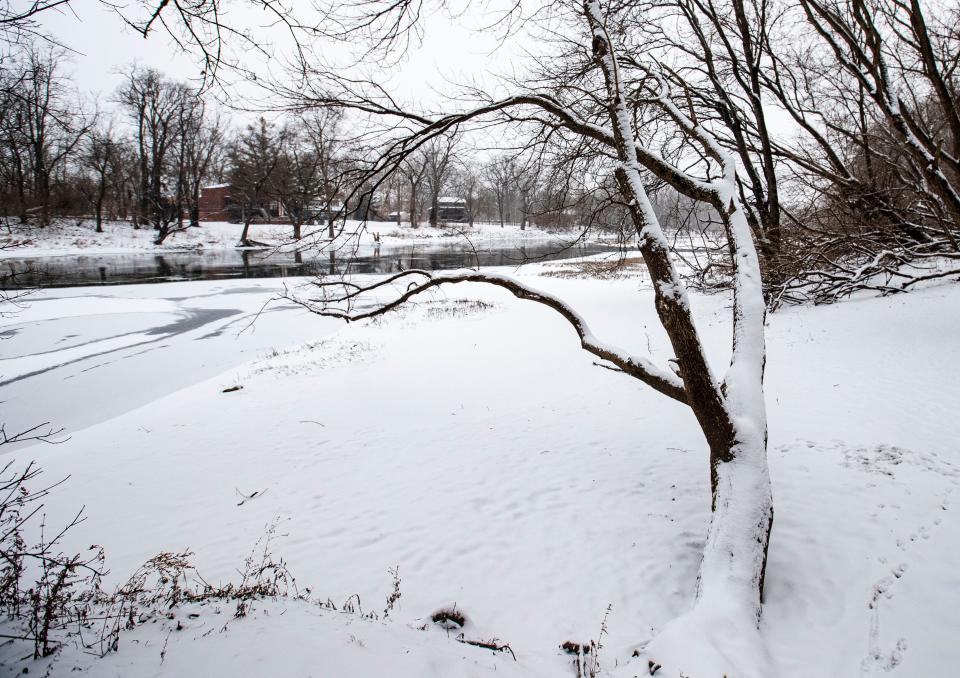Winter forecasts: Woolly worms, leaves, persimmon seeds or satellite, radar, ocean temps
Cool nights and falling leaves serve as nature’s signs of winter approaching.The big question now is: What does Mother Nature have in store for Hoosiers? Will this winter be mild or freezing and snow filled?Humans have long tried, with varying degrees of success, to predict what kind of winter awaits by using methods beginning with folklore observations and progressing to high-tech tools.
One weather prediction staple, The Farmer’s Almanac, uses a “secret formula” that is influenced by the founder’s belief in sunspots. Meteorologists who talk about weather on TV use satellite, radar and maps to identify telling patterns.

Long-range weather prediction is tricky, and over the years many have looked to signs in nature itself for answers.One tactic involves cutting open persimmons seeds. According to folklore, the shape inside a seed — all oddly looking like kitchen utensils — will predict the winter. A knife shape signifies extreme cold, a spoon is heavy snow and a fork predicts a mild winter.
Reading the signs of nature
This modern era has provided meteorologists with a wide range of tools to try and predict the oncoming winters, but reading nature for its sometimes subtle clues has stood the test of time.
Small woodland mammals, such as squirrels or rabbits, are gifted with their very own winter weather wear. A keen eye might keep watch on how fluffy these coats (and tails) get in anticipation of cold weather, while others will see if the animals are getting a little plumper. Fluffy coats and rotund bellies might lead one to believe the winter will be cold and snowy.
“When squirrels early start to hoard, winter will pierce us like a sword,” the Almanac foretells.
The Almanac also looks at plant life to guide predictions of snowfall and freezing temperatures. If oaks let loose an abundance of acorns and walnuts produce in excess, it’s believed that a cold winter is coming. And if those nuts have a shell that is thicker than normal, expect severe weather throughout the dreary months.
Vigilant observation is a crucial role in these folklore predictions. Have you ever measured an anthill? How about in July? Well if you have, you should be able to tell that a anthill built “high in July” will lead to a rather snowy winter.
It’s not just wildlife that help us prepare for the worst winter we can imagine. Sometimes the skies are said to hint at what is to come. The first day of snowfall may provide some with a sense of this year’s winter weather.
The Almanac has many hypotheses here: the date of the first snowfall may predict just how many days of snow we’ll see. If the first flake falls on the 8th, well that’s eight more storms before winter lets up.
"Some of these are based on old-fashioned observation. But some goes back to science," the Almanac says. "Interestingly, weather folklore warning of a harsh winter is based on La Niña and El Nino which are natural climate phenomenon related to the temperatures of the oceans. So, it’s a little bit of art and science! ... Other folklore is just based on the idea that you shouldn’t let your guard down."
Dreaming of a white Christmas in 2023? Here's what the forecast says
Science and technology advance
Nature may be whispering its winter intentions, but not everyone has time to bring a ruler to every anthill.
Meteorologists are now reliant on advances in science and technology to help them warn residents of impending blizzards and icy roads. They consider data from satellites, measurements of the atmosphere, computer models and radar.
While not as far reaching into the future as some folklore suggests, these machines and models give weather experts a short window into the coming days and weeks, and as the technology advances, so too does the accuracy of the weather reports.
Radars, for instance, used to be made from the same technology that used to power those old, heavy televisions sets: tubes. The resolution was low, but varying shades of gray showed the intensity of incoming precipitation. Today’s radars are much more sensitive and can now show reflectivity, velocity and other forms of analysis for meteorologists to interpret.
Satellites orbiting Earth are now used to take the temperature of the tops of clouds and collect lightning strike data to help show trends in active storms, estimate precipitation rates and even the size of hail. These data sets, along with active radar, equip meteorologists with sufficient data to make more accurate predictions.
As Hoosiers soak in the remaining autumn weather, IndyStar asked local television meteorologists what their favorite folklore and science is for prediction the weather.
What is your favorite piece of folklore to predict the upcoming winter?
IndyStar reached out to six TV meteorologists and weather experts across Indianapolis, three responded with their insights.
Christopher Wright, CBS 4 — Leaves … which fall early indicate winter will be mild. When leaves fall late, winter will be wild. If the leaves wither on the branches in October instead of falling, an extra cold winter is in store.

Brian Wilkes, FOX59 — Hands down I love the woolly worm. I’m not much on how these really ring true but in 1997 we were to have a strong El Niño and I saw a full white woolly in October. We did indeed have a mild winter with not much snow.Kevin Gregory, WRTV 6 — Love the woolly worm. I consider them nature’s meteorologist and am always on the lookout for them while driving. I don’t want to end their forecasting career early. There’s a lot going on with their folklore: the color of their bands, the direction they are traveling and maybe even the speed of their movement. The wider the black bands on the woolly worm the colder and potentially snowier the winter is expected to be. If they are headed south, that may be an indication they are headed for warmer temps! If they are traveling north, perhaps a milder winter is ahead. I don’t have much to say about their speed. Are they ever in a hurry?
From the Farmer's Almanac: How much snow will we get this winter?
What’s the best scientific evidence used to predict Indiana’s upcoming winter?
Christopher Wright — CBS 4: I usually use the forecast data from the Climate Prediction Center (https://www.cpc.ncep.noaa.gov/) and look to seasonal sea-surface temperatures to forecast a long-range winter outlook.El Niño and La Niña are the warm and cool phases of a recurring climate pattern across the tropical Pacific — the El Niño-Southern Oscillation, or “ENSO” for short. The pattern shifts back and forth irregularly every two to seven years, bringing predictable shifts in ocean surface temperature and disrupting the wind and rainfall patterns across the tropics.Brian Wilkes, FOX59 — I honestly feel everything is cyclical. While a El Niño (warning waters in the Pacific equatorial regions) has an impact on upper/air patterns and will influence the overall season — no two are ever alike.I’m not a big fan of seasonal forecasts but I will say that we are overdue for a more challenging winter. The lack of snowfall for each of the past 7-8 years has been sub normal. Only 10” total last year which included a late January “slush” storm.

I feel we may get an early taste of winter in November then it eases. Much of December could run mild, with even a few out of season thunderstorms. January should take a turn especially late month. Odds are the season may be backloaded with some of the colder and possibly snowier days. Could lead to a frustrating open to Spring.Kevin Gregory, WRTV 6 — Teleconnections can have a substantial impact on our winter weather and aid in forecasting. Conditions several thousand miles away can be “connected” to the weather patterns over North America. Sea surface temperatures in the Pacific Ocean for example, think El Niño or La Niña, can influence the movement of weather systems across the United States.Other “players” in the winter forecast are the North Atlantic Oscillation and Arctic Oscillation. Both the NAO and AO can indicate how far south cold air masses may move into the United States.

Karl Schneider is an IndyStar environment reporter. You can reach him at karl.schneider@indystar.com. Follow him on Twitter @karlstartswithk
IndyStar's environmental reporting project is made possible through the generous support of the nonprofit Nina Mason Pulliam Charitable Trust.
This article originally appeared on Indianapolis Star: Winter forecast: TV meteorologists share folklore and scientific tools

